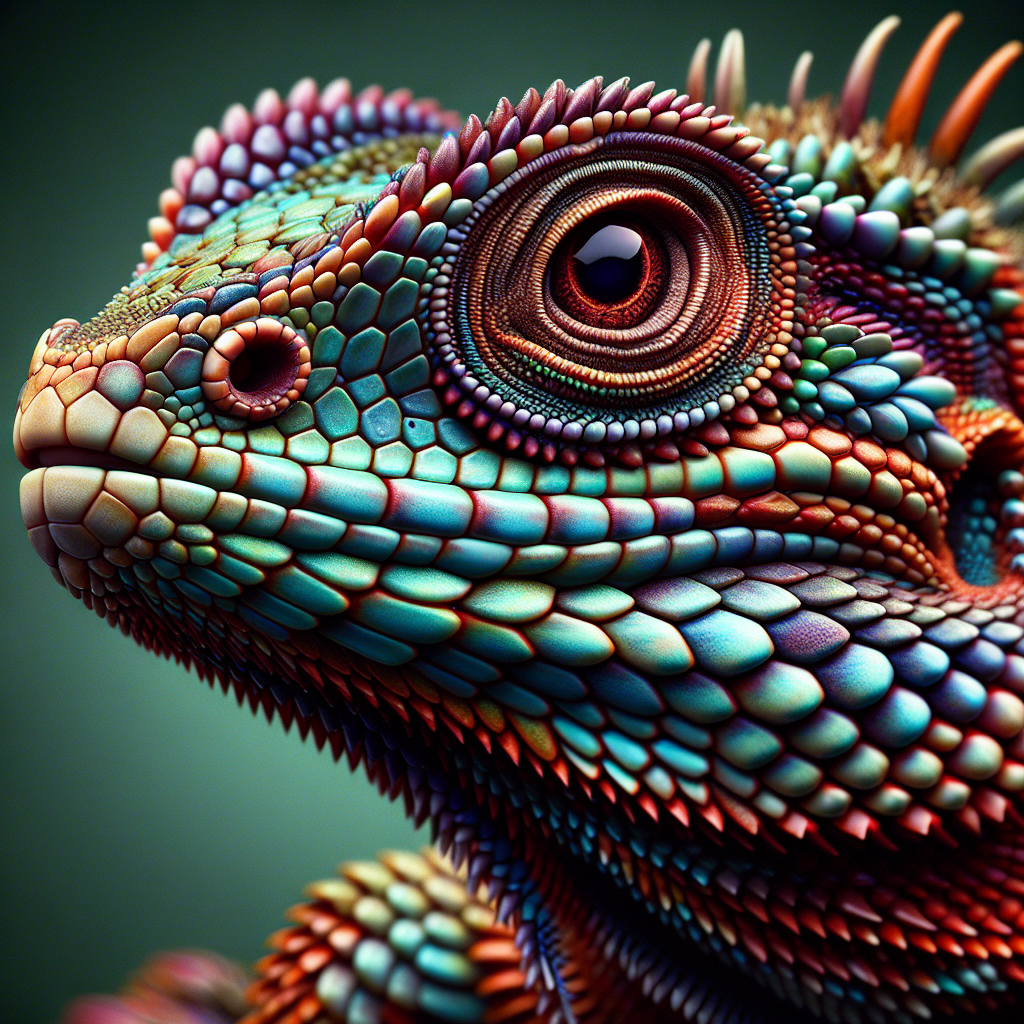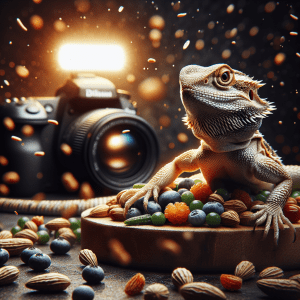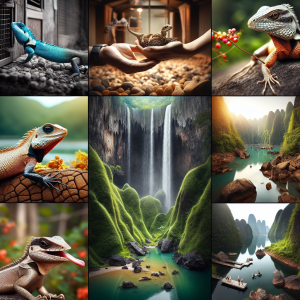Introduction: Teaching Lizards with a Multi-Sensory Approach
Have you ever stopped to think about how lizards perceive the world around them? It’s truly fascinating to dive into the sensory abilities of these remarkable creatures. Imagine having the keen eyesight of a lizard, able to detect movement from afar with precision. Picture yourself navigating your environment based on subtle vibrations and sounds, much like how lizards pick up on auditory cues.
Lizards rely heavily on their senses to survive and thrive in their habitats. From detecting potential predators to locating food sources, their senses play a crucial role in their daily lives. Did you know that some lizards have specialized sensory organs, such as the Jacobson’s organ, which allows them to detect chemical cues in the environment? It’s like having a built-in scent detector that guides their behavior and interactions with the world around them.
As we explore the intricacies of lizard senses, we uncover a world filled with wonder and complexity. How do lizards adapt to different sensory inputs in diverse environments? What challenges do they face when their senses are compromised? Understanding the nuances of lizard senses opens up a realm of possibilities for enhancing their well-being and cognitive development.
Imagine the possibilities of incorporating multi-sensory experiences into their learning process. By tailoring educational activities to engage their visual, auditory, tactile, olfactory, and gustatory senses, we can create enriching experiences that stimulate their minds and promote cognitive growth. How can we leverage their sensory capabilities to create a dynamic and engaging learning environment?
Exploring the world through the eyes, ears, and skin of a lizard offers a fresh perspective on the beauty and complexity of nature. By appreciating and understanding their sensory world, we can forge deeper connections with these fascinating creatures and enrich our own understanding of the natural world.
Understanding Lizard Senses
Understanding Lizard Senses is like diving into a fascinating world of perception that’s so different from our own. Did you know that lizards rely on a combination of senses to navigate their surroundings? It’s absolutely mind-blowing! Imagine being able to see, hear, smell, taste, and even feel the world around you in such a unique way.
One interesting fact about lizard senses is that their vision plays a crucial role in their daily activities. Lizards have incredible eyesight that allows them to detect movements and colors with precision. It’s like having built-in binoculars that help them spot prey or predators from a distance. And here’s the kicker – some lizard species can even see in ultraviolet light, a visual superpower that we humans can only dream of!
But it doesn’t stop there. Lizards also have a heightened sense of hearing, thanks to their ability to pick up low-frequency sounds that are imperceptible to us. Just imagine the world of soundscapes these creatures experience, from the rustling of leaves to the chirping of insects. It’s a symphony of nature that adds richness to their sensory perception.
Now, let’s talk about touch. Lizards use their skin as a sensory organ, capable of detecting vibrations and changes in temperature. This tactile sensitivity allows them to interact with their environment in ways we might not fully grasp. Have you ever thought about how different textures feel to a lizard? It’s a tactile adventure that adds a whole new dimension to their sensory world.
Understanding lizard senses opens up a whole new realm of appreciation for these remarkable creatures. So, the next time you see a lizard basking in the sun or darting across the ground, take a moment to marvel at the sensory symphony that guides their every move.
Benefits of Multi-Sensory Learning for Lizards
Have you ever thought about how lizards experience the world around them? It’s fascinating to consider how their unique senses play a crucial role in their learning and development. When we talk about the benefits of multi-sensory learning for lizards, we’re delving into a realm of understanding that goes beyond our typical perceptions of these reptiles.
Imagine this – lizards rely on a combination of senses to navigate their environment, communicate, and even hunt for food. Each sensory input provides them with valuable information that helps them survive and thrive in their natural habitat. By incorporating a multi-sensory approach to teaching lizards, we can tap into their innate abilities and enhance their learning experiences in captivity.
Let’s consider the practical aspect of this. When we expose lizards to a variety of sensory stimuli, we are essentially engaging their brains in a more holistic manner. Just like how humans benefit from hands-on activities, visual aids, and auditory cues in learning, lizards can also benefit from a multi-sensory educational approach. By appealing to their different senses, we can create a more enriching and stimulating learning environment for these fascinating creatures.
Think about it – how can we ensure that lizards in captivity are not only surviving but thriving? By understanding the significance of multi-sensory learning, we can provide them with the tools they need to lead fulfilling lives. So, the next time you interact with your lizard, consider how you can incorporate various sensory experiences to enhance their cognitive development and overall well-being. After all, a happy lizard is a well-rounded lizard!
Creating a Multi-Sensory Environment for Lizards
When creating a multi-sensory environment for lizards, it’s crucial to consider their unique sensory capabilities. Lizards rely on various senses to navigate their surroundings and communicate with the world around them. Picture this: imagine you’re a lizard exploring a new habitat, relying on your senses of sight, sound, touch, taste, and smell to gather information and make sense of your environment.
To ensure that your lizard feels engaged and stimulated, it’s essential to provide a diverse range of sensory inputs in their living space. Incorporating different textures, colors, and shapes can pique their curiosity and encourage exploration. Remember the time we set up that mini jungle gym for your lizard, complete with branches of varying textures and colors? Watching how it reacted to each element was fascinating!
An interesting fact to consider is that lizards have specialized sensory organs like the Jacobson’s organ, which allows them to detect chemical cues in their environment. By incorporating scents or tastes that mimic their natural surroundings, you can create a more enriching sensory experience for your lizard. Have you ever noticed how your lizard responds to certain scents or food items? It’s amazing how attuned they are to these sensory stimuli!
When designing a multi-sensory environment for your lizard, think about how you can simulate their natural habitat and provide opportunities for them to engage with different sensory inputs. For example, incorporating live plants can not only enhance the visual appeal of their enclosure but also introduce new scents and textures for them to explore. How do you think your lizard would react to a mini herb garden in its terrarium?
By considering your lizard’s sensory needs and preferences, you can create a dynamic and engaging environment that promotes their well-being and cognitive development. Remember, each lizard is unique, so don’t be afraid to experiment and tailor the sensory elements to suit your pet’s individual preferences. The key is to observe their reactions and adjust the environment accordingly to ensure they have a fulfilling and stimulating experience.
Tools and Techniques for Multi-Sensory Teaching
Let me tell you about incorporating tactile experiences for lizard learning. Picture this: you’re setting up a cozy habitat for your lizard companion, complete with various textures and surfaces for them to explore. Now, why is tactile stimulation so important for our scaly friends? Well, lizards rely heavily on touch to navigate their environment, communicate, and even hunt for food. By providing a range of textures like smooth rocks, rough bark, or soft substrates in their enclosure, you’re offering them a sensory playground that mimics their natural habitat.
Imagine watching your lizard as they glide over different surfaces, feeling the cool smoothness of a rock or the warmth of a basking spot under a heat lamp. These tactile experiences not only engage their sense of touch but also provide enrichment and mental stimulation, keeping them active and curious.
One interesting fact about lizards is that many species have specialized skin receptors that help them detect subtle changes in their environment. These receptors allow them to sense vibrations, temperature variations, and even communicate with other lizards through touch. So, when you introduce tactile elements into their environment, you’re tapping into their natural instincts and enhancing their overall well-being.
Now, here’s a practical tip for you: when setting up your lizard’s habitat, consider incorporating a variety of textures such as smooth surfaces, rough branches, and soft bedding. This diversity will not only keep your lizard physically engaged but also encourage natural behaviors like climbing, digging, and exploring.
So, next time you’re designing your lizard’s living space, think beyond the basics and add some tactile elements to create a sensory-rich environment that will keep them happy and healthy. After all, who wouldn’t want their lizard to enjoy a little touch of luxury in their everyday life?
Engaging Lizards Through Visual Stimulation
So, when it comes to engaging lizards through visual stimulation, it’s all about creating a captivating environment that appeals to their keen sense of sight. Picture this: the vibrant colors and patterns you use in their habitat can have a significant impact on their learning and overall well-being.
Remember that time I rearranged my lizard’s tank decor and added some colorful plants? It was like giving them a whole new world to explore. Lizards are naturally drawn to movement and bright hues, so incorporating visual elements like moving objects or contrasting colors can really grab their attention.
Did you know that some lizard species have excellent color vision and can even see in ultraviolet light? This fascinating fact highlights the importance of considering the visual aspects of their environment when teaching them new skills or behaviors. By leveraging their visual capabilities, you can create a visually stimulating space that enhances their learning experiences.
Now, here’s a practical tip for you: when setting up your lizard’s habitat for multi-sensory learning, think about using a variety of colors, textures, and shapes to keep them engaged. You can introduce visual cues such as target objects for them to interact with or create different zones in their enclosure to mimic their natural habitat.
By tapping into their visual senses, you’re not just making their learning sessions more enjoyable; you’re also providing them with a stimulating environment that promotes cognitive development and enrichment. So, get creative with visual stimuli and watch your lizard’s curiosity and engagement soar to new heights!
Incorporating Auditory Stimuli in Lizard Education
When it comes to incorporating auditory stimuli in lizard education, it’s truly fascinating how sound can play a crucial role in engaging our scaly friends. Did you know that lizards have a keen sense of hearing, despite lacking external ears like humans? Imagine my surprise when I first discovered this intriguing fact while delving into the world of multi-sensory teaching for lizards.
It’s like unlocking a whole new dimension to lizard learning! By introducing auditory elements into their environment, we can stimulate their auditory senses and create a more enriching learning experience. Just picture your lizard reacting to the soothing sounds of nature or the gentle hum of a calming melody. It’s like setting the perfect ambiance for a lizard classroom – who knew they could be such music enthusiasts?
Now, here’s a practical tip for you: consider playing soft, soothing music or nature sounds in the background while engaging with your lizard. This can help create a calming and conducive atmosphere for learning and interaction. Observing how your lizard responds to different sounds can also provide valuable insights into their preferences and behaviors. It’s all about tapping into their natural instincts and enhancing their educational journey in a fun and engaging way.
So, the next time you’re planning a lizard lesson, why not add a touch of auditory magic to the mix? You might be surprised by how your scaly companions react to the power of sound. After all, who wouldn’t want to see their lizard grooving to some tunes while expanding their knowledge? It’s all about exploring new possibilities and making learning a truly immersive experience for our reptilian friends.
Utilizing Tactile Experiences for Lizard Learning
When it comes to enhancing learning with olfactory and gustatory inputs for lizards, it’s all about tapping into their unique sensory world. Imagine you’re setting up a mini buffet for your lizard friend, complete with a variety of scents and tastes that will pique their curiosity and engage their senses.
Think about the last time you walked into a bakery and were immediately drawn in by the irresistible aroma of freshly baked goods. Lizards, with their keen sense of smell, can also be captivated by different scents. By introducing fragrances like herbs or fruits near their habitat, you can create a sensory-rich environment that stimulates their olfactory senses and keeps them alert and interested.
Now, let’s talk about taste. Did you know that lizards have taste buds not only on their tongues but also on the roofs of their mouths? This means they can perceive flavors in a unique way. You can experiment with offering your lizard a variety of foods with different tastes, from sweet fruits to savory insects, to cater to their gustatory preferences and provide a diverse sensory experience.
A practical tip for incorporating olfactory and gustatory inputs in lizard education is to observe your lizard’s reactions closely. Pay attention to which scents or foods they seem to enjoy the most and use this information to tailor their learning experiences. By catering to their sensory preferences, you can create a more engaging and enriching environment for your scaly companion.
By embracing the world of scents and tastes in lizard education, you not only stimulate their senses but also deepen your bond with these fascinating creatures. So, why not spice up your lizard’s learning journey with a dash of aromatic herbs and a pinch of flavorful treats? Let their senses guide them to a world of discovery and delight!
Enhancing Learning with Olfactory and Gustatory Inputs
Have you ever stopped to think about how lizards experience the world through their sense of smell and taste? It’s fascinating to consider how these often-overlooked senses play a crucial role in their learning and behavior.
When it comes to teaching lizards using a multi-sensory approach, incorporating olfactory and gustatory inputs can open up a whole new world of possibilities. Imagine this – you’re setting up a learning environment for your lizard, and you decide to introduce different scents and tastes into their surroundings. This simple addition can have a profound impact on their engagement and retention of information.
Did you know that lizards have a highly developed sense of smell that helps them navigate their environment and communicate with other lizards? By incorporating various scents into their learning activities, you can create a more enriching and stimulating experience for your reptilian friend. Additionally, lizards use their sense of taste to distinguish between different foods and potential threats, making it a valuable tool in their learning process.
One practical tip for incorporating olfactory and gustatory inputs into your lizard’s education is to use natural scents and flavors that mimic their natural environment. For example, you could introduce scents like crushed leaves or flowers to simulate the outdoors, or offer food items with different tastes to pique their curiosity and encourage exploration.
By tapping into your lizard’s sense of smell and taste, you’re not only enhancing their learning experience but also deepening your bond with them on a whole new level. So, the next time you’re planning a lesson for your scaly companion, don’t forget to add a touch of aroma and flavor to make it truly unforgettable.
Conclusion: Maximizing Learning Potential for Your Lizard
Have you ever thought about how lizards perceive the world around them? It’s fascinating to consider how these creatures rely on multiple senses to navigate their environment. When we talk about teaching lizards with a multi-sensory approach, we’re delving into a realm that goes beyond mere instruction – it’s about truly understanding and engaging with these unique reptiles in a way that resonates with their natural instincts and behaviors.
Let me share a personal anecdote that sheds light on the importance of multi-sensory teaching for lizards. A friend of mine once adopted a pet lizard named Spike. Initially, Spike seemed disinterested in traditional teaching methods, showing little response to visual cues alone. However, when my friend introduced a multi-sensory approach that incorporated tactile experiences and auditory stimuli, Spike’s engagement levels skyrocketed. It was as if the lizard had found his preferred learning style, leading to a deeper bond between Spike and his owner.
This story highlights the transformative power of multi-sensory teaching for lizards. By tapping into their natural senses and preferences, we can create enriching learning experiences that cater to their unique needs. So, if you’re looking to enhance your lizard’s learning journey, consider incorporating a variety of sensory inputs to keep them stimulated and engaged.
Remember, each lizard is different, so it’s essential to observe and adapt your teaching methods based on your pet’s responses. By embracing a multi-sensory approach, you’re not only fostering a deeper connection with your lizard but also unlocking their full learning potential. So, why not embark on this exciting educational adventure with your scaly companion?




